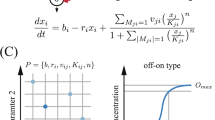Abstract
DesK is a Bacillus thermosensor kinase that is inactive at high temperatures but turns activated when the temperature drops below 25 °C. Surprisingly, the catalytic domain (DesKC) lacking the transmembrane region is more active at higher temperature, showing an inverted regulation regarding DesK. How does the transmembrane region control the catalytic domain, repressing activity at high temperatures, but allowing activation at lower temperatures? By designing a set of temperature minimized sensors that share the same catalytic cytoplasmic domain but differ in number and position of hydrogen-bond (H-bond) forming residues along the transmembrane helix, we are able to tune, invert or disconnect activity from the input signal. By favoring differential H-bond networks, the activation peak could be moved towards lower or higher temperatures. This principle may be involved in regulation of other sensors as environmental physicochemical changes or mutations that modify the transmembrane H-bond pattern can tilt the equilibrium favoring alternative conformations.




Similar content being viewed by others
References
Cybulski LE, Martín M, Mansilla MC, Fernández A, De Mendoza D (2010) Membrane thickness cue for cold sensing in a bacterium. Curr Biol 20:1539–1544
Inda ME, Oliveira RG, de Mendoza D, Cybulski LE (2016) The single transmembrane segment of minimal sensor DesK senses temperature via a membrane-thickness caliper. J Bacteriol 198:2945–2954
Aguilar PS, Hernandez-Arriaga AM, Cybulski LE, Erazo AC, De Mendoza D (2001) Molecular basis of thermosensing: a two-component signal transduction thermometer in Bacillus subtilis. EMBO J 20:1681–1691
Cybulski LE, Del Solar G, Craig PO, Espinosa M, De Mendoza D (2004) Bacillus subtilis DesR functions as a phosphorylation-activated switch to control membrane lipid fluidity. J Biol Chem 279:39340–39347
Abriata LA, Albanesi D, Dal Peraro M, De Mendoza D (2017) Signal sensing and transduction by histidine kinases as unveiled through studies on a temperature sensor. Acc Chem Res 50:1359–1366
Albanesi D, Mansilla MC, de Mendoza D (2004) The membrane fluidity sensor DesK of. J Bacteriol 186:2655–2663
Cybulski LE, Vazquez DB, Killian JA, de Mendoza D, Inda ME, Ballering J, Tieleman DP, Moussatova A, Wassenaar TA (2015) Activation of the bacterial thermosensor DesK involves a serine zipper dimerization motif that is modulated by bilayer thickness. Proc Natl Acad Sci 112:6353–6358
Inda ME, Vazquez DB, Fernández A, Cybulski LE (2019) Reverse engineering of a thermosensing regulator switch. J Mol Biol 431:1016–1024
Zhou FX, Cocco MJ, Russ WP, Brunger AT, Engelman DM (2000) Interhelical hydrogen bonding drives strong interactions in membrane proteins. Nat Struct Mol Biol 7:154–160
Stockner T, Ash WL, MacCallum JL, Tieleman DP (2004) Direct simulation of transmembrane helix association: role of asparagines. Biophys J 87:1650–1656
Yang SK, Zimmerman SC (2013) Hydrogen bonding modules for use in supramolecular polymers. Isr J Chem 53:511–520
Mariottini D, Idili A, Nijenhuis MAD, Ercolani G, Ricci F (2019) Entropy-based rational modulation of the pKa of a synthetic pH-dependent nanoswitch. J Am Chem Soc 141(29):11367–11371
Inda ME, Cybulski LE, Ruysschaert J-M, de Mendoza D, Vandenbranden M, Fernández A (2014) A lipid-mediated conformational switch modulates the thermosensing activity of DesK. Proc Natl Acad Sci 111:3579–3584
Trajtenberg F, Graña M, Ruétalo N, Botti H, Buschiazzo A (2010) Structural and enzymatic insights into the ATP binding and autophosphorylation mechanism of a sensor histidine kinase. J Biol Chem 285:24892–24903
Martín M, Albanesi D, Alzari PM, de Mendoza D (2009) Functional in vitro assembly of the integral membrane bacterial thermosensor DesK. Protein Expr Purif 66:39–45
Soto Diaz S, Betton J-M, Buschiazzo A, Alzari PM, Mechaly AE, Sassoon N (2017) Structural coupling between Autokinase and phosphotransferase reactions in a bacterial histidine kinase. Structure 25:939.e3–944.e3
Albanesi D, Martin M, Trajtenberg F, Mansilla MC, Haouz A, Alzari PM, de Mendoza D, Buschiazzo A (2009) Structural plasticity and catalysis regulation of a thermosensor histidine kinase. Proc Natl Acad Sci 106:16185–16190
Bargmann CI, Hung MC, Weinberg RA (1986) Multiple independent activations of the Neu oncogene by a point mutation altering the transmembrane domain of p185. Cell 45:649–657
Bargmann CI, Weinberg RA (1988) Oncogenic activation of the neu-encoded receptor protein by point mutation and deletion. EMBO J 7:2043–2052
Matsushita C, Tamagaki H, Miyazawa Y, Smith SO, Sato T, Aimoto S (2013) Transmembrane helix orientation influences membrane binding of the intracellular juxtamembrane domain in Neu receptor peptides. Proc Natl Acad Sci 110:1646–1651
Berntsson O, Diensthuber RP, Panman MR, Björling A, Gustavsson E, Hoernke M, Hughes AJ, Henry L, Niebling S, Takala H, Ihalainen JA, Newby G, Kerruth S, Heberle J, Liebi M, Menzel A, Henning R, Kosheleva I, Möglich A, Westenhoff S (2017) Sequential conformational transitions and α-helical supercoiling regulate a sensor histidine kinase. Nat Commun 8:1–7
Bi S, Jin F, Sourjik V (2018) Inverted signaling by bacterial chemotaxis receptors. Nat Commun 9:2927–2940
Diensthuber RP, Bommer M, Gleichmann T, Möglich A (2013) Full-length structure of a sensor histidine kinase pinpoints coaxial coiled coils as signal transducers and modulators. Structure 21:1127–1136
Acknowledgements
This work was supported by Grants from Consejo Nacional de Investigaciones Científicas y Técnicas (CONICET), Agencia Nacional de Promoción Científica y Tecnológica (FONCYT), and international cooperations: CONICET-Fonds National de la Recherche Scientifique (FNRS). M.E.I., J.C.A and D.B.V are Fellows of CONICET, and L.E.C., A.B. and A.F. are Career Investigators of CONICET.
Author information
Authors and Affiliations
Contributions
MEI, DBV, AB and JCA performed the experiments and discussed the results. LEC envisioned and coordinated the project and wrote the manuscript. JMR, AF and MEI contributed to the writing.
Corresponding author
Additional information
Publisher's Note
Springer Nature remains neutral with regard to jurisdictional claims in published maps and institutional affiliations.
Rights and permissions
About this article
Cite this article
Inda, M.E., Almada, J.C., Vazquez, D.B. et al. Driving the catalytic activity of a transmembrane thermosensor kinase. Cell. Mol. Life Sci. 77, 3905–3912 (2020). https://doi.org/10.1007/s00018-019-03400-1
Received:
Revised:
Accepted:
Published:
Issue Date:
DOI: https://doi.org/10.1007/s00018-019-03400-1




